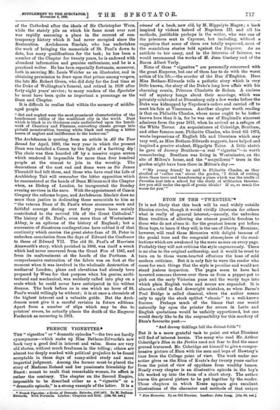ST. PAUL'S.t IT is strange that, though volumes in abundance
hare been written about St. Faure Cathedral, no work in any way iv:lel:late has appeared since the publication of Dean Milman's Annals in 1868. The forty years that intervene have witnessed the transformation of a national memorial, magnificent indeed, but cold and dull to the last degree, into the great centre of spiritual life in the capital of the Empire. And they have seen a well-ordered and systematic attempt to complete the internal decorations
• A Century of French Poet,: s Selection Illuidratiog the History of French Poetry during the lad Hundred Years. With an Introduction, dc., by Francis Yvon Eccles. London A. Constable and Co. ilds: 6d. neta 1- Memorials of Ht. Paters Cathedral. By William Elaadonakt Sinclair, D.E., Archdeacon of London. With Illustrations by Louis Wedrter.R.B.A. London: Chapman and Ball. [168. net.]
of the Cathedral after the ideals of Sir Christopher Wren, while the stately pile on which his fame must ever rest was rapidly assuming a place in the current of con- temporary history which it had never occupied since the Restoration. Archdeacon Sinclair, who has undertaken the work of bringing the memorials of St. Paul's down to date, has many qualifications for the task ; he has been a member of the Chapter for twenty years, he is endowed with abundant information and genuine enthusiasm, and he is a practised writer. He has been especially fortunate, moreover, both in securing Mr. Louis Weirter as an illustrator, and in obtaining permission to draw upon that prince among vergers, the late Mr. Robert Green, who did duty for the first time at the Duke of Wellington's funeral, and retired in 1809 after forty-eight years' service; to many readers of the Spectator he must have been quite as important a personage as the Dean and Chapter.
It is difficult to realise that within the memory of middle- aged people
"dirt and neglect were the most prominent characteristics ef the handsomest edifice of the wealthiest city in the world. Dust which is black in its thickness rests undisturbed upon the handi- work of Chantrey and Flaxman, converting classic groups into piebald monstrosities, turning white black and reading a bitter lesson of neglect and indifference to the looker-on."
The Archdeacon is quoting from an article in All the Year Round for April, 1868, the very year in which the present Dean was installed a Canon by the light of a farthing dip! The choir was then boarded off by a massive organ screen which rendered it impossible for more than four hundred people at the utmost to join in the worship. The decorations of the east end and dome were as Sir James Thornhill had left them, and those who have read the Life of Archbishop Tait will remember the bitter opposition which he encountered at the hands of Dean Milman and the Chapter when, as Bishop of London, he inaugurated the Sunday evening services in the nave. With the appointment of Canon Gregory the reforms began, and Archdeacon Sinclair does no more than justice in dedicating these memorials to him as " the veteran Dean of St. Paul's whose strenuous work and faithful courage during over forty years have mainly contributed to the revived life of the Great Cathedral." The history of St. Paul's, even more than of Westminster Abbey, is an epitome of the history of England ; but a succession of disastrous conflagrations have robbed it of that continuity which carries the great sister-fame of St. Peter in unbroken association from the days of Edward the Confessor to those of Edward VII. The old St. Paul's of Harrison Ainsworth's story, which perished in 1666, was itself a wreck which had never recovered from the Great Fire of 1561, and from its maltreatment at the hands of the Puritans. A comprehensive restoration of the fabric was on foot at the moment when it was involved in the wholesale destruction of mediaeval London ; plans and elevations had already been prepared by Wren for that purpose when his genius, archi- tectural and mechanical, was suddenly called into play on a scale which he could never have anticipated in his wildest dreams. The book before us is one which no lover of St. Paul's would willingly be without; it is at once a chronicle of the highest interest and a valuable guide. But the Arch- deacon must give it a careful revision in future editions. Apart from a number of slips which may be due to printers' errors, he actually places the death of the Emperor Frederick as occurring in 1901.































































 Previous page
Previous page